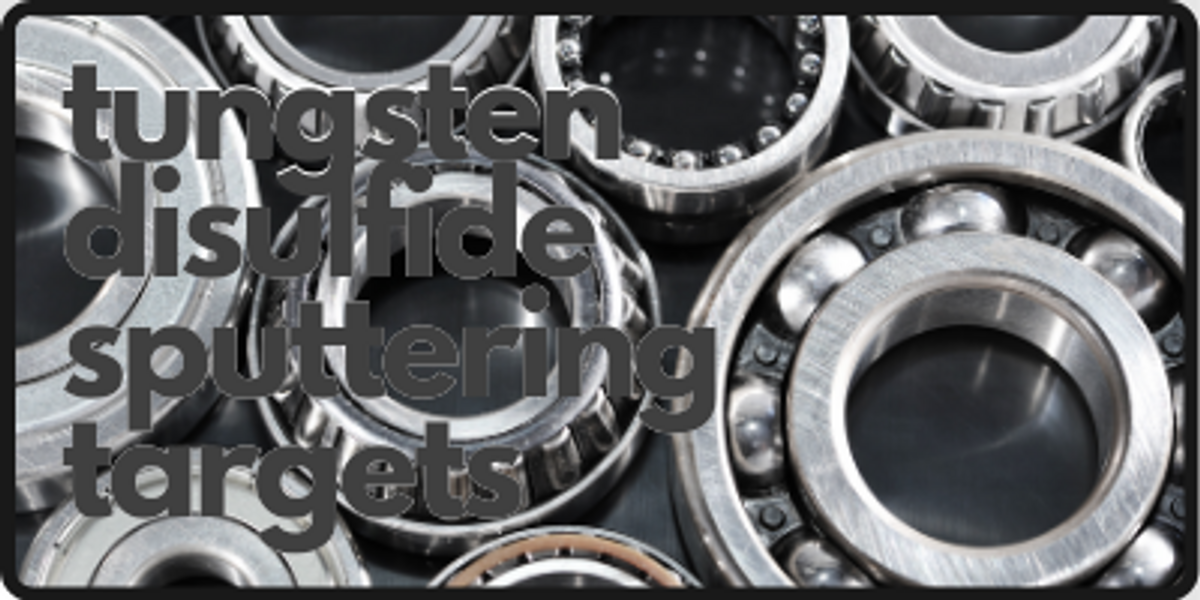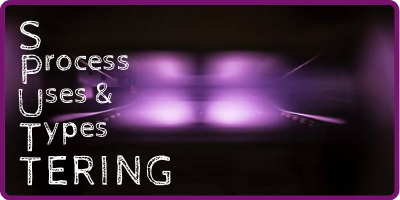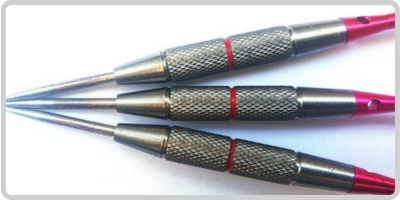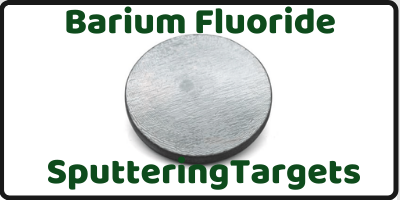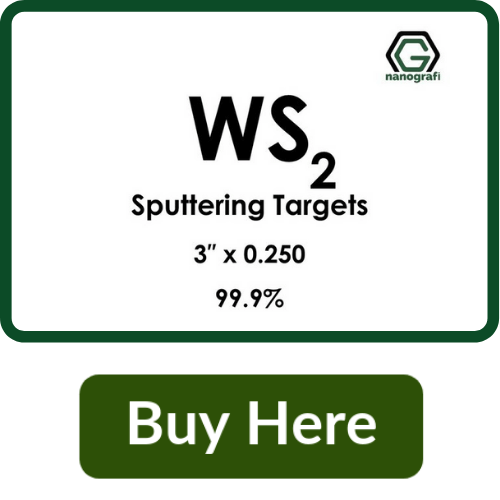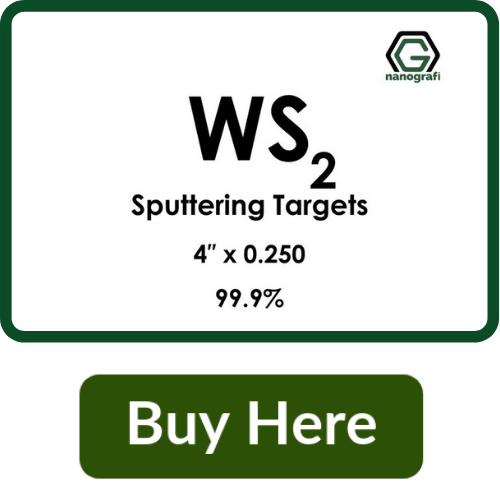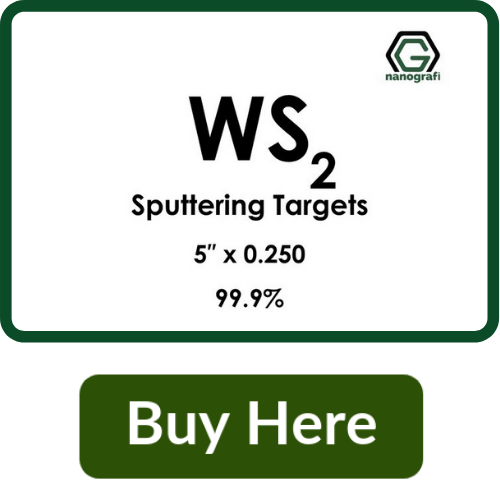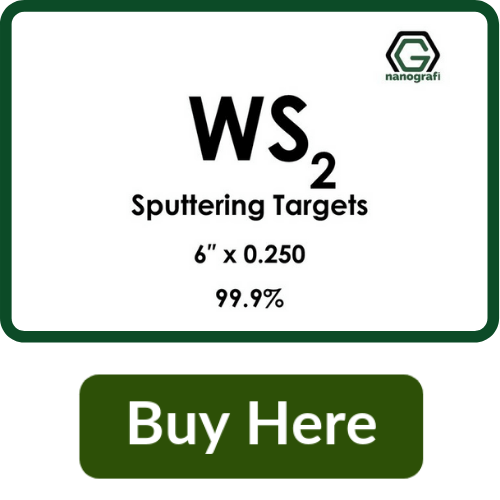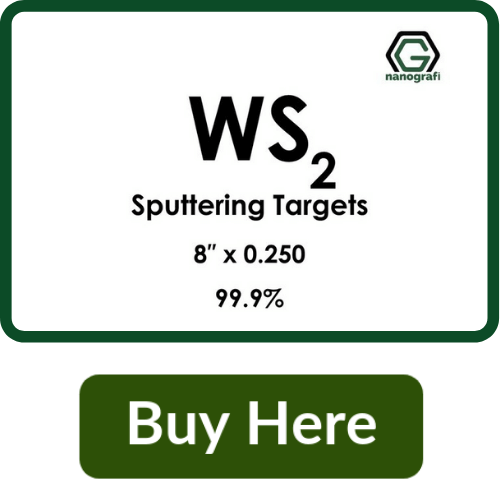Tungsten Disulfide Sputtering Targets and Applications
Tungsten disulfide with the molecular formula of WS2 is a super lubricant (zero friction) and a crystalline structure. Tungsten sulfide exhibits excellent tribological properties meaning it is wear-resistant, lubricant and has no friction. The tribological property of WS2 originates from its axial ratio with the numerical of at least 1.87 in order to adopt a low friction coefficient. Tungsten sulfide has six nonbonding electrons that for a positive charge network on its surface layer and are limited in their structure. This behavior of electrons in tungsten sulfide makes it easy to go through its electrostatic repulsive force. Tungsten sulfide isn’t easily oxidized and has a higher thermal stability. The oxidization resistant property of tungsten sulfide is due to the formation of tungsten oxide (WO3). Tungsten sulfide thin films can be grown on stainless steel by pulsed laser deposit where the steady-state friction coefficient against counter face is only 0.04. The WS2-based thin films in this way, are around 60nm thick transparent enough for electron beam 1.
Before You Continue, Check This Article About Sputtering Targets Also
Tungsten Disulfide Properties
Tungsten sulfide is classified among the very interesting two-dimensional materials known as transition metal dichalcogenide (TMDC). Similar to other known 2D materials, WS2 exhibits unique optoelectrical (optical and electrical) behaviors and in a broad energy range, it has strong affinity to protons as well high carrier capability in wide wavelength rage. Tungsten disulfide is covalently bounded to six other neighboring chalcogenides in the same plane and binds to sheets and layers above and below its plane by Van der Waals forces. Two dimensional materials like WS2 have natural self-passivated surfaces with no dangling bonds. This makes it easy for the 2D materials to integrate them with photonic structures like cavities and waveguide structures (waveguide structures are able to guide electromagnetic waves and sound with the least waste of energy through confining the waves and transmission energy to only one direction). Moreover, using two dimensional materials, it is possible to stack different 2D materials on each other vertically and create heterostructures that lack any conventional lattice mismatch. The films made by tungsten disulfide are originally and highly thin and interact strongly with incident light absorbing some 10% of that. Tungsten sulfide and versatile two-dimensional material is able to interact with electromagnetic light at a wide range of spectrum due to its electronic properties 2.
What is Sputtering Target
Generally, sputtering is a technique to deposit low-temperature thin films with applications in large-area coatings solid materials like glass, metals and steel. Sputtering, a technique in physics and a naturally occurring phenomenon in space, takes place when the surface of a solid material is bombarded by high-energy particles a gas or plasma with the subsequent ejection of microscopic particles. The sputtering techniques are widely used to create an extremely fine layer of a particular metal on a substrate, conduct analytical experiments, perform etching at practically precise level, manufacture thin films of semiconductors, optical devices coatings and nanoscience. Technically, when incident ions with higher energy collide with target atoms on the surface of solids, they exchange momentum triggering collision cascades in the adjacent particles. The collision cascades with energy greater than that of the surface target binding energy, an atom is ejected from the surface. This ejection of an atom is called sputtering. The high energy incidents ions are created by particle accelerator, radio frequency magnetron, plasma, ion sources, alpha radiation from radioactive materials and solar wind from space. Among the sources mentioned above, the radio frequency magnetron is used a lot to deposit two-dimensional materials in glass substrates. This is used to study the effect on thin films with an application in solar cells 3. Two-dimensional materials have applications as high-performance transistors, semiconductors in phase-change memory and spintronic devices 4.
Tungsten Disulfide Preparation for Sputtering
So far, numerous methods of tungsten disulfide coatings and sputtering have been introduced. In general, the tungsten thin films are prepared using magnetron sputtering from a tungsten target in a rare gas (argon) atmospheres H2S (Ar-H2S). The substrate temperature is set at 620˚C. The electron microscopy, the in-situ X-ray diffraction and elastic reoil detection analysis are used to study the growth of films and nucleation. Particularly, a transportable sputtering and an energy dispersive X-ray diffraction perform at the synchrotron radiation source. The elastic recoil detection analysis along with Kr, Xe and Au heavy ions is used to evaluate the deposition of films. The considerable lattice expansion of the WS2 crystals is possible at low substrate temperatures, low sputtering pressure and high deposition rate. This expansion is due to the turbo static and disturbed film growth triggered by high-energy bombardment during the deposition. The main source of the energetic bombardment is the reflected and neutralized high-energy ions of Ar0S0 generated by tungsten target and S- anion which are accelerated in the cathode 5.
Click Image to Learn Also About Properties of Tungsten
Tungsten Disulfide Sputtering Applications
Tungsten disulfide is considered as a material with highest lubrication property providing excellent dry lubricity. Since WS2 doesn’t match any other substance it can be applied as a perfect agent between layers. Tungsten disulfide has a broad thermal stability as it is resistant to minimum temperature of -270˚C to 650˚C in the Earth atmosphere and in outer space and vacuum condition, it is stable at -188˚C to 1316˚C making it a capable lubricious agent to be applied in space exploration equipment and devices. Currently, WS2 sputtering has applications in mechanical and automotive parts, shafts, marine transportation engine parts, race cars engines, aerospace technology, ball, linear and roller bearings, engine pistons, gears with high precision and so forth. Tungsten disulfide thins films show excellent electrical transport and performance properties. There are recent reports of WS2-based transistors as well as vertically stacked WS2-graphene transistors used on flexible substrates 6.
Tungsten disulfide sputtering and coating exhibit interesting performances and properties with a broad range of thermal stability and resistance, especially in vacuum conditions with numerous applications in space technology. The formation of tungsten disulfide thin films creates excellent lubrication behavior on its counter face. The tribological features of tungsten sulfide (wear, lubricity and zero-friction) are influenced by the temperature where the lower the temperature, the smaller the friction and higher lubrication behavior.
Click Images to Discover other Sputtering Targets
References
1. Joly-pottuz, L. & Iwaki, M. Superlubricity of Tungsten Disulfide Coatings in Ultra High Vacuum. Superlubricity (Elsevier B.V., 2007). doi:10.1016/B978-0-444-52772-1.50045-7
2. Polyakov, A. Y. et al. Magnetron sputtered WS 2 ; optical and structural analysis. (2016). doi:10.1088/1742-6596/707/1/012028
3. Sobayel, K. et al. OPEN WS 2 : A New Window Layer Material for Solar Cell Application. 1–11 (2020). doi:10.1038/s41598-020-57596-5
4. Huang, J. et al. Polymorphism Control of Layered MoTe 2 through Two-Dimensional Solid-Phase Crystallization. Sci. Rep. 1–8 (2019). doi:10.1038/s41598-019-45142-x
5. Phys, J. A. Reactive magnetron sputtering of tungsten disulfide films : Influence of deposition parameters on texture , microstructure , and stoichiometry. 2323, (2013).
6. Ovchinnikov, D. et al. Electrical Transport Properties. 8174–8181 (2014). doi:10.1021/nn502362b
Recent Posts
-
Nanocomposites in Food Packaging
The utilization of nanocomposites in food packaging represents a significant advancement in the fiel …19th Apr 2024 -
What is the Difference Between 7075 and 6061 Aluminum Alloy?
When comparing 7075 aluminum alloy to 6061 aluminum alloy, it's essential to understand their disti …5th Apr 2024 -
Iron-Air Batteries: The Ultimate Guide
Iron-air batteries represent a significant breakthrough in energy storage technology, offering a sus …29th Mar 2024

